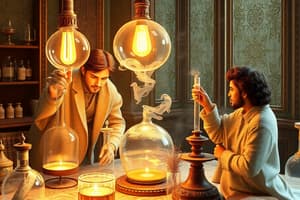Podcast
Questions and Answers
Which area is NOT a target for research and development in the Science for Change Program (S4CP)?
Which area is NOT a target for research and development in the Science for Change Program (S4CP)?
- Information technology advancements (correct)
- Agricultural and aquatic productivity
- Creative industries, tourism, and service industries
- Health, food, and nutrition
Why did Buensalido Architecture suggest using 'green' materials in construction?
Why did Buensalido Architecture suggest using 'green' materials in construction?
- To reduce construction costs (correct)
- To increase the durability of homes
- To encourage air circulation within homes
- To follow American and European design trends
What makes the bahay kubo an ideal home for a tropical location?
What makes the bahay kubo an ideal home for a tropical location?
- Its resistance to earthquakes
- Its compatibility with modern architectural styles
- Its ability to deal with humidity, heat, and flooding (correct)
- Its efficient use of space
Why are American and European designs unsuitable for tropical climates?
Why are American and European designs unsuitable for tropical climates?
What is the primary benefit of building homes elevated on stilts in tropical locations?
What is the primary benefit of building homes elevated on stilts in tropical locations?
Which of the following is NOT a key aspect of Indigenous Knowledge Systems and Practices (IKSPs) in the Philippines as mentioned in the text?
Which of the following is NOT a key aspect of Indigenous Knowledge Systems and Practices (IKSPs) in the Philippines as mentioned in the text?
What did Buensalido Architecture stress about the availability of materials needed for 'going green' in construction?
What did Buensalido Architecture stress about the availability of materials needed for 'going green' in construction?
How do the walls of a bahay kubo contribute to its ability to keep the house cool?
How do the walls of a bahay kubo contribute to its ability to keep the house cool?
'Science for the People' S4CP aims to promote scientific innovations primarily in which sector?
'Science for the People' S4CP aims to promote scientific innovations primarily in which sector?
What was the collaborative project between Buensalido Architecture and Lamudi.com focused on?
What was the collaborative project between Buensalido Architecture and Lamudi.com focused on?
Flashcards are hidden until you start studying
Study Notes
Scientific Theories and Philosophies
- Scientific Antirealism: unobservable concepts, such as electrons and genes, are inherently unverified and require physical evidence to be accepted as real.
- Constructive Empiricism: science aims to give a true story of the Universe based on observable aspects.
- Instrumentalism: scientific theories are merely instruments for solving problems and making predictions.
- Social Constructivism: scientific knowledge is borne out of collective observations and verified by a particular group at a particular time.
- Reductionism: a thesis about ontologies, laws, theories, linguistic expressions, or some combination of these.
- Theoretical Pluralism: promotes a multidisciplinary approach to various fields of science rather than a succession of knowledge.
Hyperhistory and Philippine Science and Technology
- Hyperhistory: a new stage in human evolution, where advancements in Information and Communications Technology (ICT) play a significant role.
- Philippine Science and Technology: development rooted in both history and hyperhistory, with the progression of knowledge and mankind depending on them.
History of Philippine Science and Technology
- Precolonial Scientific Conditions: early Filipinos had a simple level of technological development, with skills in boatbuilding, metallurgy, weaving, agriculture, and pottery.
- Spanish Occupation: established gender-specific schools, with the Royal and Pontifical University of Santo Tomas being the oldest university in the country.
- American Occupation: limited education to the elite and wealthy, with uneducated people employed in manual labor.
Psychology
- Freudian Slip: an action borne of the unconscious mind interfering with the conscious mind.
- Human Mind: has three aspects, namely the Id (basic instincts), ego (the conscious mind), and superego (the conscience).
Current Developments in Philippine Science and Technology
- Duterte's Support: Philippine President Rodrigo Duterte announced a budget increase for the Department of Science and Technology to provide research and entrepreneurial opportunities.
- National Science and Technology Week (NSTW) 2017: theme was "Science for the People," with the goal of promoting entrepreneurship and benefiting the people.
- Philippine Space Technology Program: officially marked the Philippines' intention of joining the "space race."
Philippine Development Plan 2017-2022
- Overall Framework: anchored on the Ambisyon Natin 2040, aiming to enable Filipinos to attain a matatag, maginhawa, at panatag na buhay.
- Goal: acknowledges the accomplishments of previous administrations, adopts good practices, and considers lessons learned from past experiences.
Notable Filipino Scientists
- Ramon Barba: ranked third in the top 100 Asian scientists list for his work on horticulture, particularly on mango trees bearing flowers regardless of seasons.
- Angel Alcala: ranked seventh for his work on Philippine reptiles and amphibians.
- Edgardo Gomez: ranked ninth for his national-scale assessment of damages to coral reefs.
- Mahar Lagmay: ranked tenth for his work on disaster readiness and risk reduction app, Project NOAH.
- Gavino Cajulao Trono, Jr.: ranked twelfth for his study on tropical marine phycology.
Science for Change Program (S4CP)
- Target areas for R&D: agricultural and aquatic productivity, health, food and nutrition, human security, creative industries, tourism, and service industries, and nuclear science for health, agriculture, and energy.
Indigenous Filipino Materials and Methods
- Use of sustainable materials: advocated for the use of local materials in construction and daily living to reduce costs and promote eco-friendliness.
- Bahay kubo: an ideal home design for tropical locations, with features such as elevated structure, sawali weaving, and air circulation to keep the house cool and avoid floods.
Studying That Suits You
Use AI to generate personalized quizzes and flashcards to suit your learning preferences.





